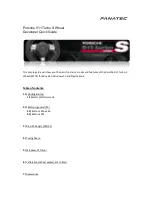
Air Brakes
WARNING:
Do not use the gearshift selector in place of the
parking brake; unexpected and possible sudden vehicle
movement may occur if these precautions are not taken. Always set the
parking brake fully AND make sure the gearshift selector is in position
R
for vehicles equipped with manual transmission or position
N
(except
Allison 2200 transmission) or
P
(Allison 2200 transmission) for vehicles
with automatic transmission.
If the service brakes should fail to operate while your vehicle is moving,
you can make an emergency stop with the parking brake. Since the
parking brake only applies stopping power to the rear wheels, your
vehicle’s stopping distance greatly increases and the handling of your
vehicle is adversely affected. Make repairs immediately to an inoperative
air brake system circuit.
WARNING:
This control is used for parking only. Do not leave
the vehicle unattended after setting the parking brake without
placing the transmission inposition
R
for vehicles equipped with manual
transmission or position
N
(except Allison 2200 transmission) or
P
(Allison 2200 transmission) for vehicles with automatic transmission.
Use of wheel chocks is also recommended in hilly or off-road usage.
Pull the yellow parking brake knob
out to apply the parking brake.
Push the knob in to release the
parking brake.
The parking brake light illuminates and remains illuminated
(when you switch the ignition to the on position) until you
release the parking brake.
Releasing Spring Brake with Air Pressure
The air system in all vehicles with spring-actuated rear wheel parking
brakes is equipped with a tank valve located on the supply or service air
tank for connection to an outside air supply. The valve lets you recharge
P
152
Brakes
2015 F-650/750
(f67)
Owners Guide gf
(ownloose)
, 1st Printing, December 2013
Canadian_French
(fr_can)
















































